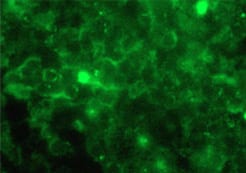Cationic polymers are promising as nonviral gene vectors due to their controlled structures, high condensation ability, and relatively low cytotoxicity. Writing in the Journal of Polymer Science Part A: Polymer Chemistry, Peihong Ni and colleagues report the synthesis of brush copolymers with biodegradable polyphosphoester (PPE) side chains, specifically [poly(2-hydroxyethyl methacrylate)-graft-poly(ethylethylene phosphate)]-block-poly[2-(dimethylamino)ethyl methacrylate] [(PHEMA-g-PEEP)-b-PDMAEMA].
Nucleic acid molecules (DNA, RNA, etc.) are degraded by enzymes in the bloodstream. Therefore, carriers are required to efficiently deliver DNA into cells. However, high cytotoxicity and unspecific reactions of the gene vectors with blood components lead to rapid clearance from circulation. The introduction of brush copolymers on the surface of gene vectors enhance the lifetime in blood circulation, resistance against self-aggregation, and nonspecific adsorption with negatively-charged components in the bloodstream.
“Gene therapy is a promising non-invasive treatment for many hardly-curable diseases, and appropriate carriers that can efficiently deliver DNA/RNA into cells are urgently needed to enhance the bioavailability and bring out maximum therapeutic efficacy,” says Ni. “Here, the biggest advance is the novel introduction of the biodegradable polyphosphoester as side chains to replace the traditionally-used non-biodegradable poly(ethylene glycol) or analogues, as well as the extended development of brush copolymer in gene delivery application.”

The fluorescence microscopy images of the transfected HeLa cells using the (PHEMA33-g-PEEP112)-b-PDMAEMA66/DNA complexes
The (PHEMA-g-PEEP)-b-PDMAEMA with PPE side chains was synthesized via a combination of SET-LRP and ring opening polymerization techniques. The in vitro cytotoxicity and transfection tests indicated that these brush copolymers showed low cytotoxicity and were able to efficiently deliver DNA into HeLa cells.
“We think the most important application for this approach is gene or drug delivery. It will provide some theoretical basis for designing safe and efficient gene vector based on biodegradable materials and brush copolymer,” explains Ni.
Further research will focus on studying the biological properties of the (PHEMA-g-PEEP)-b-PDMAEMA with PPE side chains. In addition, Ni would like to introduce more functions in this system, such as stimuli-responsive moiety or fluorescence or targeted molecules, and aims to synthesize multifunctional vectors with good biocompatibility and biodegradability, as well as site-specific and stimuli-triggered release of the nucleic acid molecules.















